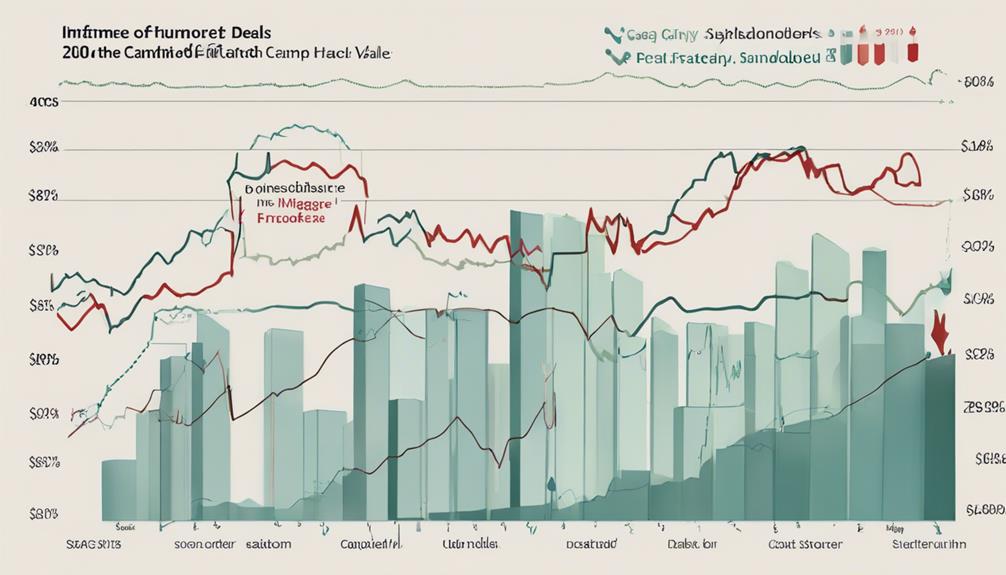Assessing the Impact of Stock Mergers on Shareholders

As investors, it's crucial to carefully analyze how stock mergers impact shareholder wealth. By examining abnormal returns, operational performance, short-term price fluctuations, and long-term consequences, we can gauge the true value created or destroyed.
Understanding factors like diversification, payment methods, and cross-border considerations is essential. Evaluating reverse mergers also yields valuable insights. Through meticulous analysis of these key areas, we can make well-informed decisions that maximize shareholder benefits.
Delving deeper into these aspects can unveil a more comprehensive understanding of how stock mergers profoundly influence our investment portfolios.
Key Takeaways
- Study abnormal stock returns to understand the impact of the merger on shareholders. This can help determine if the merger is viewed positively or negatively by the market.
- Analyze financial statements to evaluate changes in revenue, profitability, and operational efficiency after the merger. This can provide insights into the financial health of the merged entity and the potential benefits for shareholders.
- Keep an eye on short-term stock price movements to gauge market reactions and identify any potential risks for investors. Understanding how the market responds to the merger can help in making informed investment decisions.
- Consider the long-term impact on shareholder wealth by assessing the strategic rationale, financial stability, and synergy potential of the merger. This can help in understanding the sustainability of the benefits for shareholders over time.
- When negotiating merger terms, aim to secure favorable terms such as premium ratios and effective risk management strategies. This can help maximize the benefits for shareholders and ensure that their interests are protected during and after the merger.
Analyzing Abnormal Stock Returns
To evaluate the impact of stock mergers on shareholder wealth, we analyze the abnormal stock returns surrounding merger announcements. Abnormal returns depict the difference between a stock's actual performance and its expected performance, offering insights into the market's perception of the merger. Positive abnormal returns indicate that investors perceive the merger as value-creating, while negative abnormal returns may signal skepticism or concerns regarding the transaction.
Stock mergers can take various forms, such as horizontal mergers where companies in the same industry combine, vertical mergers involving companies in different stages of the production process, or conglomerate mergers between unrelated businesses. Each type of merger can have different implications for shareholder wealth and market dynamics.
Analyzing abnormal stock returns allows us to gauge how the market views these different types of mergers. Positive abnormal returns following a horizontal merger, for example, may suggest synergies and cost-saving opportunities that investors find appealing. On the other hand, negative abnormal returns after a conglomerate merger could indicate uncertainties about the strategic fit or potential integration challenges between the merging entities.
Evaluating Operating Performance Changes
When looking at abnormal stock returns, we gain insights into investor sentiment, but it's equally important to assess changes in operating performance to understand how stock mergers impact shareholder wealth.
Shareholders pay close attention to financial statements to analyze the effects of mergers on key metrics such as revenue growth and profitability.
For instance, before the merger, the company had an 8% revenue growth rate, which increased to 12% post-merger. Additionally, profitability, as measured by EBITDA Margin, rose from 15% before the merger to 18% after the merger.
Enhanced operational efficiency resulting from a merger can create value for shareholders, a trend observed in many successful mergers.
By monitoring these essential performance indicators, we can evaluate the success of the integration and make informed decisions about the combined entity's long-term sustainability.
Ultimately, the impact of stock mergers on shareholders depends on the merged company's ability to deliver consistent growth and profitability, as reflected in its operating performance evolution.
Examining Short-term Stock Price Effects

When examining the short-term effects of mergers on stock prices, it's crucial to consider how different types of mergers can impact the market reaction. Stock prices of companies involved in mergers can experience significant fluctuations post-announcement, which can result in gains or losses for investors. Factors like market sentiment, cost-saving potential, and debt levels of the merging entities are key determinants of the initial market response.
In a stock merger scenario, where one company acquires another by exchanging its shares, the immediate impact on stock prices can vary. The market's perception of the merger, including the expected synergies and financial stability of the combined entity, can influence whether stock prices rise or fall in the short term. Shareholders need to closely monitor these price movements to gauge the immediate effects on their investment portfolios.
Understanding the dynamics of stock mergers and their effects on stock prices is essential for investors to make informed decisions and manage risks during the merger process. By paying attention to factors such as market reactions, cost efficiencies, and debt management strategies, investors can better navigate the short-term fluctuations in stock prices following a merger announcement.
Comparing Bidder and Target Returns
Studies consistently demonstrate that shareholders of target firms in mergers stand to gain substantial abnormal returns in comparison to shareholders of bidding firms. Targets often experience significant short-term abnormal returns and higher merger premiums, leading to potential growth in their investments.
On the other hand, bidders tend to encounter lower abnormal returns, indicating a contrasting outcome for their stockholders in merger deals. The disparities in stock price effects between bidders and targets have been evident in mergers and acquisitions across both the UK and the US.
These findings highlight the intricate nature of assessing shareholder value creation prospects in stock mergers. As we delve deeper into this subject, it becomes apparent that a nuanced comprehension of the factors influencing bidder and target returns is crucial for investors and corporate leaders navigating the dynamic landscape of mergers and acquisitions.
Assessing Long-term Merger Consequences

As we delve into the long-term effects of stock mergers, it's crucial to consider how different types of mergers and acquisitions can impact shareholder wealth. Not all mergers are the same, and the type of merger can influence how shareholders fare in the long run.
By analyzing the strategic rationale behind the merger, such as whether it's a horizontal, vertical, or conglomerate merger, we can better predict how it will affect stock prices, dividends, and ownership stakes over time.
Understanding the financial stability and market performance of the newly merged company is essential for gaining insights into the sustained impact on shareholders. By closely monitoring key financial indicators and market trends, investors can make informed decisions about their investment in the merged entity. This ongoing evaluation is crucial for assessing the long-term consequences of the merger and its implications for shareholder value.
Ultimately, the ability of a merger to create synergies and enhance shareholder value is key to determining its long-term success. By identifying and capitalizing on opportunities for value creation post-merger, companies can ensure that shareholders continue to benefit from the combined entity's growth and profitability.
Through careful analysis and strategic planning, companies can maximize the long-term benefits of mergers for their shareholders.
Shareholder Wealth Implications
Stock mergers can have complex implications for shareholder wealth in the long term. Factors like the successful realization of synergies, market conditions, relative valuations, and shareholder behavior all play a role in determining the impact on shareholders' wealth.
When merged companies effectively integrate their operations and achieve the anticipated synergies, they're more likely to generate positive long-term returns for shareholders. On the other hand, if these synergies aren't realized as expected, it can lead to disappointing outcomes for shareholders.
Market conditions also play a crucial role in determining the long-term implications for shareholder wealth. Stock performance post-merger can vary based on the region and the prevailing market conditions at the time of the merger. This variability can influence the overall wealth of shareholders in the long run.
Additionally, the relative valuations of the merging companies can impact shareholder wealth in the long term. If a highly valued company merges with a lower-valued one, it may result in long-term losses for shareholders of the acquiring company.
Furthermore, studies have shown that some merged companies may experience negative long-term abnormal returns, which can have a detrimental effect on shareholder wealth. Understanding these factors is essential for maximizing shareholder value in the long run amidst the evolving landscape of mergers and acquisitions.
Synergistic Value Creation
Mergers are often pursued to create synergistic value, which can ultimately benefit shareholders in the long term. By pooling together resources and capabilities, companies aim to achieve higher operational efficiency and profitability, thereby strengthening their market position and gaining a competitive edge. Research suggests that when synergistic value is effectively harnessed, shareholders may witness positive abnormal returns over an extended period following the merger.
Analyzing key performance indicators, market responses, and strategic alignment allows us to evaluate the lasting impact of mergers on shareholder wealth. Mergers that lead to enhanced operational efficiency, expanded market presence, and increased competitiveness are likely to yield the most substantial long-term benefits for shareholders. By prioritizing the creation of synergistic value, companies can unlock the full potential of mergers and deliver enduring value to their investors.
Factors Influencing Shareholder Value Creation
Analyzing the impact of stock mergers on shareholders involves considering several key factors. One important aspect to explore is the synergy potential of the merger. Synergy refers to the combined value that the merged companies can create that's greater than the sum of their individual values. This synergy can result from cost savings, increased revenue opportunities, or enhanced operational efficiencies. By realizing synergies, companies involved in a merger can potentially increase shareholder value through improved financial performance and growth prospects.
Another factor to consider is the effect of diversification on shareholder value. Diversification can have both positive and negative impacts on shareholders. On one hand, diversifying into new markets or industries can reduce risk and increase the overall stability of a company, which can be beneficial for shareholders. On the other hand, excessive diversification without a clear strategic rationale can dilute the focus of the company and lead to decreased shareholder value. It's important for companies engaging in mergers to carefully consider the impact of diversification on shareholder value and ensure that it aligns with their overall strategic goals.
The regulatory environment also plays a significant role in shaping the outcomes of stock mergers for shareholders. Regulatory approval is often required for mergers to proceed, and regulatory scrutiny can impact the timeline and success of a merger. Additionally, regulatory changes or interventions can affect the competitive landscape and market dynamics, ultimately influencing shareholder value. Companies involved in stock mergers must navigate the regulatory environment effectively to mitigate potential risks and maximize shareholder value.
Synergy Potential Assessment
Assessing synergy potential is crucial when evaluating the value creation opportunities of a stock merger. It's essential to thoroughly analyze the factors that can boost shareholder returns and understand how the combined value of the two companies can exceed their individual performances.
Key factors that influence synergy potential include:
- cost savings from economies of scale,
- streamlined operations, and improved efficiencies.
Additionally, revenue growth can be achieved through:
- cross-selling,
- expanding customer bases, and
- capturing a larger market share.
Integrating complementary resources, capabilities, and best practices can also lead to operational efficiencies and improved financial performance post-merger, ultimately increasing shareholder value.
Successfully integrating operations, resources, and capabilities is vital to realizing the full synergy potential of a stock merger. This integration can result in a stronger and more competitive entity with enhanced growth opportunities, benefiting shareholders in the long run.
Therefore, a thorough analysis of synergy potential is essential for understanding the overall impact of stock mergers on shareholders.
Diversification Impact on Value
Stock mergers can significantly impact shareholder value through diversification. By combining stocks from different companies, mergers can lower risk and increase exposure to various markets. The success of these diversification benefits plays a crucial role in creating value for shareholders in mergers. Implementing effective post-merger diversification strategies is essential for boosting shareholder wealth and driving portfolio growth.
Various factors such as industry diversification, geographic expansion, and product mix play a vital role in determining the value generated for shareholders in stock mergers. Industry diversification enables access to new markets and revenue streams, reducing dependence on a single sector.
Expanding the geographic footprint introduces companies to new customer bases and growth prospects. A diversified product portfolio enhances resilience against market fluctuations, providing stability and potential for growth.
Regulatory Environment Influences
Regulations play a critical role in shaping how stock mergers impact shareholder value creation. Here are some key ways in which regulations can influence this process:
- Disclosure Requirements: Regulations that require comprehensive disclosure of merger details help in promoting transparency. This transparency allows shareholders to make well-informed decisions when it comes to mergers.
- Shareholder Approval: Regulations mandating shareholder approval for mergers give investors a say in the process. This ensures that their interests are taken into account and protected throughout the merger.
- Anti-competitive Practices: Regulations that examine the potential anti-competitive effects of mergers help in preventing market concentration. By maintaining a healthy competitive environment, these regulations benefit both shareholders and the market as a whole.
- Oversight and Enforcement: Regulatory oversight and enforcement mechanisms build trust among shareholders. This trust reinforces the integrity of the merger process and ensures its long-term benefits are realized.
Compliance with these regulatory factors is crucial for market stability and safeguarding shareholder rights. Ultimately, adhering to these regulations contributes to the sustainable creation of value for investors during stock merger transactions.
Role of Event Window Selection

When examining stock mergers, the choice of event window is crucial for understanding how shareholders are impacted. The pre-announcement, announcement, and post-announcement periods are commonly used event windows in merger studies, each offering distinct insights into how investors' stock prices are affected.
Researchers often use multiple event windows to gain a comprehensive understanding of how mergers influence shareholder wealth.
Selecting the event window significantly affects the calculation of abnormal returns and cumulative abnormal returns, key metrics for measuring the market's response to merger announcements. Accurately capturing these stock price movements is essential for evaluating the true impact of mergers on shareholder value.
Implications of Economic Conditions
Economic conditions play a significant role in shaping the outcomes of stock mergers, impacting shareholder value in various ways. There are four primary ways in which economic factors influence the results of these corporate combinations:
- In times of economic downturns, merger activity tends to decrease as market uncertainty undermines investor confidence, leading to potential losses for shareholders.
- Conversely, during periods of economic prosperity, stock mergers are more likely to result in higher returns for shareholders due to increased market stability and growth opportunities.
- Fluctuations in interest rates and inflation levels can significantly impact shareholder confidence in the success of stock mergers, influencing their decisions and outcomes.
- Broader economic indicators such as GDP growth and unemployment rates can have a profound effect on the overall performance and long-term success of stock mergers, directly impacting shareholder interests.
Understanding these implications is crucial for corporate leaders aiming to optimize shareholder value, particularly in times of economic instability. By closely monitoring relevant economic conditions and trends, leaders can make well-informed decisions that safeguard and enhance shareholder interests.
Strategies for Thorough Merger Evaluation

When evaluating a stock merger, it's crucial to analyze the financial statements before the merger. This analysis helps us understand how the merger might impact shareholder value. Keeping an eye on stock prices and news related to the merger is also important to make well-informed decisions throughout the evaluation process.
Understanding the exchange ratios and collar agreements is key to grasping the premium offered and the risk management strategies for shareholders. Additionally, we need to consider how changes in voting rights after the merger could affect shareholders' control and influence within the new entity.
It's essential to stay updated on dividend policies and potential changes post-merger to gauge the impact on shareholder income. By delving into these aspects of a stock merger, we can make a comprehensive assessment that takes into account various factors affecting shareholders and the overall financial health of the merged entity.
Maximizing Shareholder Benefits From Mergers
As shareholders, it's crucial to maximize the benefits from mergers. Understanding the different types of mergers and acquisitions can help us navigate the process more effectively.
One common type is a stock merger, where two companies combine by exchanging shares. This type of merger can lead to increased market capitalization and shareholder value.
When evaluating merger synergies, it's important to consider how the combined company's strengths and weaknesses complement each other. By identifying areas where the companies can work together to create more value, we can ensure that the merger is beneficial for shareholders.
Negotiating favorable terms, such as a fair exchange ratio for shares, can also help maximize shareholder benefits.
Protecting our interests as shareholders during a merger is essential. This can involve conducting thorough due diligence on the companies involved, understanding the potential risks and rewards, and actively participating in shareholder meetings and votes. By staying informed and engaged throughout the merger process, we can ensure that our interests are safeguarded.
Evaluate Merger Synergies
Identifying and realizing merger synergies is crucial for maximizing the benefits that shareholders can gain from corporate consolidations. As experts in evaluating the impact of stock mergers on shareholder wealth, we recognize four key elements to consider:
- Cost Savings: Merging companies can take advantage of economies of scale, streamline operations, and eliminate redundant functions to achieve significant cost savings.
- Revenue Enhancements: Synergies can unveil new growth opportunities, expand market reach, and promote the cross-selling of products and services to drive revenue growth.
- Operational Efficiencies: Integrating best practices, technologies, and talent can enhance productivity and improve overall operational performance.
- Strategic Advantages: Mergers can strengthen competitive positioning, increase bargaining power, and provide access to new capabilities and resources.
Efficient synergy realization is essential for delivering on the promised benefits to shareholders from stock mergers. By clearly communicating the potential synergies and actively monitoring their achievement, companies can instill confidence in investors and ensure successful integration.
Negotiate Favorable Terms
Negotiating favorable terms is crucial for shareholders looking to maximize the benefits of stock mergers. By securing premium exchange ratios, we can ensure that our stake in the new entity reflects our investment. Collar agreements, which establish minimum and maximum price ranges for our stock, can also help protect our interests by managing the financial risks involved in the merger.
When negotiating, it's important to focus on securing premium exchange ratios. This approach can significantly enhance shareholder value and ensure that our investment is well-represented in the new entity. Implementing collar agreements is another key strategy to consider. These agreements can safeguard against price fluctuations and provide a level of stability during the merger process.
An additional consideration is ensuring the financial health of the new entity post-merger. By prioritizing the long-term performance and stability of the company, shareholders can position themselves for sustained success. However, it's essential to be prepared for potential integration challenges that may arise as a result of the merger.
Understanding the intricacies of exchange ratios and their impact on shareholder value is essential during negotiations. By utilizing strategic negotiation tactics, we can advocate for terms that protect our interests and set us up for success in the evolving landscape following the merger.
Protect Shareholder Interests
Safeguarding shareholder interests is crucial in managing stock mergers, as our goal is to maximize the benefits from these corporate transactions. It's essential to meticulously analyze the merger terms to ensure the best possible outcomes for our stakeholders.
To protect shareholder interests effectively, we should employ four key strategies:
- Carefully evaluate exchange ratios to secure a favorable premium on our shares.
- Negotiate collar agreements to protect against downside risks in case of stock price fluctuations.
- Monitor how the stock prices of the merging partners affect the premium we receive, enabling us to make well-informed decisions.
- Insist on transparent communication regarding merger synergies to enhance shareholder value in the post-merger period.
Potential Pitfalls of Merger Transactions

While stock mergers offer potential advantages, shareholders may encounter various pitfalls that could impact their financial interests. One issue is the risk of dilution, where shareholders may see a reduction in their ownership stakes in the new company post-merger. This could lessen their influence and control over the organization, affecting their ability to shape important decisions.
Furthermore, changes in voting rights during a merger can limit shareholders' impact on critical company matters, diminishing their say in the direction of the combined entity. This loss of voting power can lead to a sense of disempowerment among shareholders as they navigate the post-merger landscape.
Stock price volatility is another concern following a merger, introducing uncertainty that may affect the overall value of shareholders' investments. This fluctuation in stock prices can create challenges in assessing the true financial impact of the merger, potentially leading to confusion and dissatisfaction among shareholders.
Communication gaps regarding the benefits of the merger can exacerbate these issues, fostering misconceptions and reducing shareholders' confidence in the deal. Clear and transparent communication is crucial in addressing these concerns and ensuring that shareholders understand the rationale behind the merger.
Moreover, fluctuations in dividend payments post-merger can impact shareholders' income levels and financial planning, adding another layer of complexity to the merger process. It's essential for shareholders to stay informed and actively monitor these changes to protect their financial interests throughout the merger.
Shareholder Wealth Effects of Diversifying Mergers
Diversifying mergers can bring about various benefits for acquiring firms, potentially boosting shareholder wealth. Research indicates that these mergers can result in positive abnormal returns, increasing the acquiring company's market capitalization. Let's delve into the advantages of diversifying mergers:
Synergy creation is a significant benefit of diversifying mergers. By combining the strengths and capabilities of the merging entities, valuable synergies can be generated, leading to improved financial performance.
Moreover, diversifying mergers can help acquiring firms gain a competitive edge in the industry by expanding their market presence. This strategic advantage can contribute to long-term success and growth.
Another advantage is risk reduction. Through diversification of operations, acquiring firms can spread out risks and enhance the stability of their overall business, safeguarding against potential downturns in specific markets.
Ultimately, diversifying mergers have the potential to create shareholder value by driving growth and value creation for the company. This can translate into increased wealth for shareholders in the long run.
Impact of Method of Payment

The method of payment in stock mergers can significantly impact shareholder wealth, with cash payments generally leading to substantial returns compared to stock issuance. Research indicates that acquiring shares of the acquiring company can result in noteworthy returns for shareholders in stock mergers. Additionally, cash payments combined with acquiring the target firm as a wholly-owned subsidiary are recommended strategies for maximizing returns in these transactions.
Investors tend to view cash payments more favorably than stock issuance, as the latter is often perceived as a less desirable way of financing the merger. This perception can have a significant influence on shareholder wealth and the overall reception of the merger deal.
Understanding these preferences can help companies make more informed decisions about the structure of their stock mergers, ultimately increasing value for their shareholders.
Cross-border Merger Shareholder Considerations
Let's dive into how cross-border mergers can affect shareholders in terms of increased ownership control, regulatory challenges, and currency exchange considerations.
When a company acquires a foreign target and establishes it as a wholly-owned subsidiary, shareholders can potentially see a boost in their wealth. However, it's crucial for companies to carefully navigate the intricate web of compliance requirements that vary across different jurisdictions.
Moreover, the fluctuations in currency values during the merger process can have a significant impact on shareholder returns for both the acquiring company and the target company. These currency fluctuations can add a layer of complexity to the merger deal and may require strategic planning to mitigate any potential negative effects on shareholder value.
Cross-border Ownership Implications
When companies merge across borders, shareholders should carefully assess how the ownership structure may change and the implications that come with it. These changes can bring about various challenges that significantly affect our influence and decision-making power.
One significant impact of cross-border mergers is on voting rights. The merging companies may alter shareholder voting structures, potentially diminishing our ability to actively participate in the governance of the company. This shift can limit our say in important decisions that affect our investments.
Navigating regulatory obstacles is another crucial consideration for shareholders in cross-border mergers. The differences in laws and governance practices between the countries of the merging entities can create significant regulatory hurdles. Shareholders must be prepared to address and comply with these diverse regulations to protect their interests.
Currency fluctuations are also a key concern for shareholders in cross-border mergers. Changes in exchange rates can impact the value of our investments in the merged company, leading to fluctuations in the returns we receive. It's essential to monitor these fluctuations and assess their potential effects on our financial position.
Additionally, communication barriers stemming from cultural differences between the merging companies can impact shareholder engagement, governance, and decision-making processes. Shareholders must adapt to these cultural nuances and communicate effectively to ensure their voices are heard in the post-merger entity.
Regulatory Compliance Challenges
Understanding the regulatory compliance landscape is a critical challenge shareholders must tackle in cross-border mergers, as the legal frameworks and governance structures often vary significantly between the merging entities' jurisdictions. Navigating these complex environments is essential to ensure compliance with multiple sets of rules and regulations, which can have a profound impact on our rights, voting procedures, and overall ownership interests.
To successfully navigate the intricacies of cross-border mergers, a deep understanding of the regulatory requirements in each market is crucial. Failing to adhere to these requirements can jeopardize the merger process and put our investments in jeopardy. Therefore, it's imperative for us, as shareholders, to collaborate closely with legal and financial advisors to comprehensively analyze the implications of the transaction and formulate a detailed compliance strategy.
The success of cross-border mergers hinges on our ability to safeguard our interests and facilitate a seamless transition post-merger. By proactively addressing regulatory compliance challenges, we can play a pivotal role in shaping the future of the combined entity and preserving the value of our investments.
Currency Conversion Considerations
When shareholders engage in cross-border mergers, they not only navigate regulatory complexities but also need to consider how currency conversion will affect the value of their holdings in the new combined entity. The exchange rates at the time of the merger's completion play a crucial role in determining the actual value of one's shares in the newly formed stock. It's vital for shareholders to comprehend this process to effectively manage their financial exposure.
Shareholders should evaluate several key factors, such as the potential volatility in exchange rates stemming from economic instability, inflation, or geopolitical events. Understanding the currency conversion methodology employed by the merging companies is essential. Additionally, examining historical exchange rate trends between the involved currencies and assessing the impact of currency fluctuations on one's investment portfolio are crucial aspects to consider.
Analyzing the types of mergers and acquisitions, particularly in the context of stock mergers, can provide shareholders with valuable insights into the potential outcomes of currency conversion on their holdings. By considering these factors and staying informed about market trends, shareholders can make informed decisions to safeguard their investments during cross-border mergers.
Reverse Mergers and Shareholder Considerations

When considering a reverse merger, shareholders need to carefully weigh the potential risks and rewards. In a reverse merger, a private company merges with a public company, allowing the private entity to become publicly traded without going through an initial public offering (IPO). This can give private companies access to public capital markets, but shareholders should understand the implications involved in such a transaction.
Before proceeding with a reverse merger, it's crucial to assess the financial health and growth prospects of the newly merged entity. Since reverse mergers can bring together companies with varying strengths and weaknesses, it's essential to evaluate the long-term viability of the combined organization.
Furthermore, shareholders should be aware of the legal and regulatory complexities that come with a reverse merger as they can significantly impact the overall outcome of the transaction.
On the positive side, reverse mergers can offer private companies a quicker and more cost-effective route to becoming publicly traded compared to a traditional IPO. However, shareholders must carefully weigh these advantages against the potential risks, such as decreased transparency or questionable business practices.
Frequently Asked Questions
Do Mergers Increase Shareholder Value?
We believe that mergers in the form of stock mergers can potentially increase shareholder value through synergies, acquisition premiums, and diversification for shareholders. By effectively managing the financing of the deal, companies can create long-term value for investors seeking innovation in the market.
Stock mergers involve the combination of two companies through a transaction where the acquirer pays for the target company's shares with its own stock. This type of merger can lead to cost synergies, revenue synergies, and strategic synergies that can benefit the combined entity and its shareholders.
Historical data has shown that well-executed stock mergers have the potential to create value for shareholders by increasing market share, reducing costs, and enhancing competitiveness in the industry. Companies that successfully integrate their operations and capitalize on the strengths of both entities can realize significant financial gains for their shareholders.
Why Do Mergers Destroy Shareholder Value?
Mergers in the stock market can erode shareholder value for various reasons. One common cause is the tendency for companies to overpay for the acquisition of another business. This can lead to a dilution of the acquiring company's shares and a decrease in overall shareholder wealth. Additionally, poor integration between the merging entities can result in operational inefficiencies, decreased productivity, and ultimately, a negative impact on stock prices.
Moreover, the failure to realize anticipated synergies is another factor that can contribute to value destruction in mergers. When companies merge, they often expect to achieve cost savings, revenue growth, or other strategic benefits through synergies. However, if these synergies are not fully realized or take longer to materialize than expected, shareholders may become skeptical of the merger's value proposition, leading to a decline in stock prices.
Market skepticism can also play a significant role in the erosion of shareholder value post-merger. Investors may doubt the strategic rationale behind the merger, question the potential benefits, or view the deal as unfavorable for one or both parties involved. This skepticism can result in a decrease in stock prices as investors adjust their valuations based on perceived risks and uncertainties associated with the merger.
Do Mergers Create Value for Shareholders of Acquired Firms?
Mergers and acquisitions can have different outcomes for shareholders, depending on the type of deal involved. There are various types of mergers, such as horizontal, vertical, and conglomerate mergers, each with its own set of implications for shareholders.
For example, in a stock merger, shareholders of the acquired company are often offered shares in the acquiring company as part of the deal. This can result in a spike in stock prices for the acquired company's shareholders, as they become part owners of a larger, more diversified entity. However, the ultimate value creation for shareholders depends on the successful realization of synergies through financial restructuring post-merger.
Research has shown that stock mergers can be a double-edged sword for shareholders. While initial stock price spikes may seem promising, the long-term success and value creation for shareholders depend on the ability of the merged entity to leverage synergies and create a more competitive and profitable business. In essence, the proof of value creation lies in the ability of the merged company to deliver on the promises made during the merger process.
What Happens to Shareholders in an Acquisition?
Shareholders in a stock merger can experience a variety of changes, including adjustments to their voting rights, the necessity of obtaining regulatory approvals, and potential challenges following the merger. However, if the integration process is executed effectively, there is the potential for significant long-term strategic benefits that could truly transform the landscape for innovative shareholders.
There are different types of mergers and acquisitions that companies can engage in, each with its own set of implications for shareholders. For example, a horizontal merger involves two companies that operate in the same industry and may lead to increased market share and efficiency. On the other hand, a vertical merger involves companies in different stages of the production process, which can result in cost savings and improved supply chain management.
In the context of a stock merger, shareholders may see changes in their ownership stakes and the value of their investments. It is crucial for shareholders to carefully evaluate the terms of the merger, including any potential synergies and risks involved. By staying informed and actively participating in the decision-making process, shareholders can maximize their benefits and navigate any challenges that may arise post-merger.
Conclusion
After conducting a comprehensive analysis of stock mergers and their impact on shareholders, the results are unequivocal: while there may be initial positive effects on stock prices, the long-term outcomes often diverge from this trend. When examining abnormal returns, operational performance, and the effects on shareholder wealth, it becomes apparent that the success of a merger is influenced by a multitude of factors, including the payment method and the specific characteristics of the merger itself. The true implications for shareholders are multifaceted and require in-depth investigation.
Various types of mergers and acquisitions can significantly influence shareholder value. For instance, horizontal mergers, where companies in the same industry combine, may lead to increased market share and cost efficiencies. On the other hand, vertical mergers, involving companies at different stages of the production process, could result in improved supply chain coordination and reduced transaction costs. Additionally, conglomerate mergers, which involve companies in unrelated industries, may diversify risk but could also present challenges in integration and management.
Stock mergers, whether friendly or hostile, can have distinct effects on shareholders. Friendly mergers, where both parties agree to the terms, often lead to smoother integration and potentially higher shareholder returns if synergies are realized. In contrast, hostile takeovers, where one party pursues the merger without the other's consent, can create uncertainty and resistance among shareholders, impacting stock prices and long-term performance.
It is essential for investors to carefully evaluate the implications of stock mergers on shareholder value, considering factors such as the strategic rationale behind the merger, the execution plan, and the potential synergies that can be achieved. By conducting thorough due diligence and monitoring the post-merger performance, shareholders can make informed decisions to protect their investments and maximize returns in the dynamic landscape of corporate mergers and acquisitions.





